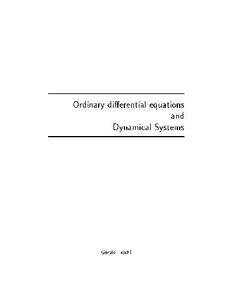
Ordinary differential equations PDF
Preview Ordinary differential equations
Ordinary differential equations and Dynamical Systems Gerald Teschl Gerald Teschl Institut fu¨r Mathematik Nordbergstraße 15 Universit¨at Wien 1090 Wien, Austria E-mail: [email protected] URL: http://www.mat.univie.ac.at/~gerald/ 1991 Mathematics subject classification. 34-01 Abstract. Thismanuscriptprovidesanintroductiontoordinarydifferential equations and dynamical systems. We start with some simple examples of explicitly solvable equations. Then we prove the fundamental results concerning the initial value problem: existence, uniqueness, extensibility, dependence on initial conditions. Furthermore we consider linear equations, the Floquet theorem, and the autonomous linear flow. ThenweestablishtheFrobeniusmethodforlinearequationsinthecom- plexdomainandinvestigatesSturm–Liouvilletypeboundaryvalueproblems including oscillation theory. Next we introduce the concept of a dynamical system and discuss sta- bility including the stable manifold and the Hartman–Grobman theorem for both continuous and discrete systems. We prove the Poincar´e–Bendixson theorem and investigate several ex- amples of planar systems from classical mechanics, ecology, and electrical engineering. Moreover,attractors,Hamiltoniansystems,theKAMtheorem, and periodic solutions are discussed as well. Finally, there is an introduction to chaos. Beginning with the basics for iterated interval maps and ending with the Smale–Birkhoff theorem and the Melnikov method for homoclinic orbits. Keywords and phrases. Ordinary differential equations, dynamical systems, Sturm-Liouville equations. Typeset by AMS-LATEX and Makeindex. Version: October 21, 2004 Copyright (cid:13)c 2000-2004 by Gerald Teschl Contents Preface vii Part 1. Classical theory Chapter 1. Introduction 3 §1.1. Newton’s equations 3 §1.2. Classification of differential equations 6 §1.3. First order autonomous equations 8 §1.4. Finding explicit solutions 11 §1.5. Qualitative analysis of first order equations 17 Chapter 2. Initial value problems 23 §2.1. Fixed point theorems 23 §2.2. The basic existence and uniqueness result 26 §2.3. Dependence on the initial condition 29 §2.4. Extensibility of solutions 32 §2.5. Euler’s method and the Peano theorem 34 §2.6. Appendix: Volterra integral equations 37 Chapter 3. Linear equations 43 §3.1. Preliminaries from linear algebra 43 §3.2. Linear autonomous first order systems 50 §3.3. General linear first order systems 55 §3.4. Periodic linear systems 59 iii iv Contents Chapter 4. Differential equations in the complex domain 65 §4.1. The basic existence and uniqueness result 65 §4.2. Linear equations 67 §4.3. The Frobenius method 70 §4.4. Second order equations 74 Chapter 5. Boundary value problems 83 §5.1. Introduction 83 §5.2. Symmetric compact operators 86 §5.3. Regular Sturm-Liouville problems 91 §5.4. Oscillation theory 96 Part 2. Dynamical systems Chapter 6. Dynamical systems 105 §6.1. Dynamical systems 105 §6.2. The flow of an autonomous equation 106 §6.3. Orbits and invariant sets 109 §6.4. Stability of fixed points 113 §6.5. Stability via Liapunov’s method 115 §6.6. Newton’s equation in one dimension 116 Chapter 7. Local behavior near fixed points 121 §7.1. Stability of linear systems 121 §7.2. Stable and unstable manifolds 123 §7.3. The Hartman-Grobman theorem 128 §7.4. Appendix: Hammerstein integral equations 132 Chapter 8. Planar dynamical systems 135 §8.1. The Poincar´e–Bendixson theorem 135 §8.2. Examples from ecology 139 §8.3. Examples from electrical engineering 143 Chapter 9. Higher dimensional dynamical systems 149 §9.1. Attracting sets 149 §9.2. The Lorenz equation 152 §9.3. Hamiltonian mechanics 156 §9.4. Completely integrable Hamiltonian systems 160 §9.5. The Kepler problem 165 Contents v §9.6. The KAM theorem 166 Part 3. Chaos Chapter 10. Discrete dynamical systems 173 §10.1. The logistic equation 173 §10.2. Fixed and periodic points 176 §10.3. Linear difference equations 178 §10.4. Local behavior near fixed points 180 Chapter 11. Periodic solutions 183 §11.1. Stability of periodic solutions 183 §11.2. The Poincar´e map 184 §11.3. Stable and unstable manifolds 186 §11.4. Melnikov’s method for autonomous perturbations 189 §11.5. Melnikov’s method for nonautonomous perturbations 194 Chapter 12. Discrete dynamical systems in one dimension 197 §12.1. Period doubling 197 §12.2. Sarkovskii’s theorem 200 §12.3. On the definition of chaos 201 §12.4. Cantor sets and the tent map 204 §12.5. Symbolic dynamics 207 §12.6. Strange attractors/repellors and fractal sets 211 §12.7. Homoclinic orbits as source for chaos 215 Chapter 13. Chaos in higher dimensional systems 219 §13.1. The Smale horseshoe 219 §13.2. The Smale-Birkhoff homoclinic theorem 221 §13.3. Melnikov’s method for homoclinic orbits 222 Bibliography 227 Glossary of notations 229 Index 230 Index 231 Preface The present manuscript constitutes the lecture notes for my courses Ordi- nary Differential Equations and Dynamical Systems and Chaos held at the University of Vienna in Summer 2000 (5hrs.) and Winter 2000/01 (3hrs), respectively. It is supposed to give a self contained introduction to the field of ordi- nary differential equations with emphasize on the view point of dynamical systems. Itonlyrequiressomebasicknowledgefromcalculus, complexfunc- tions,andlinearalgebrawhichshouldbecoveredintheusualcourses. Itried to show how a computer system, Mathematica, can help with the investiga- tion of differential equations. However, any other program can be used as well. The manuscript is available from http://www.mat.univie.ac.at/~gerald/ftp/book-ode/ Acknowledgments I wish to thank my students P. Capka and F. Wisser who have pointed out several typos and made useful suggestions for improvements. Gerald Teschl Vienna, Austria May, 2001 vii Part 1 Classical theory
